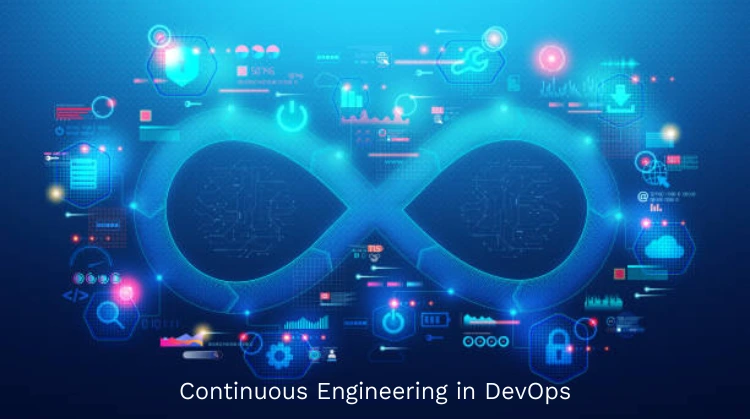DevOps and continuous engineering are the new best friends in the tech world today. Let’s find out this relationship’s why, what, and how. Engineering can be defined as applying certain principles – be it scientific, mathematical, or any other principle- to design and build something that can solve a problem.
The efficiency of the build greatly depends on how well the design has been engineered for all the parts in the build to act either in tandem or independently or all at once depending upon the need. In other words, engineering provides invisible lubrication that allows the smooth functioning of different parts of a thing. If there is a flaw in engineering, the required smoothness or lubrication will be missing, resulting in improper functioning or sometimes, even crashing. The thing here can be a vehicle, machine, or software!
The Why
Unlike yesteryears when software development used to take months and years altogether, the rapid growth in the digital economy demanded faster software development, and luckily DevOps came to the rescue, and software teams have been successful in delivering agile solutions in the software field.
Together with the help of cloud services, DevOps teams thrived not only in delivering quality software solutions that are quick to deploy and maintain but also brought various erstwhile isolated groups of an organization under one team. Cloud DevOps engineering services have been the most sought-after services for quite some time now. But again, even this top-notch approach to software development isn’t sufficient for the fast-growing market coupled with even faster-changing consumer demands.
The software product in today’s world needs to be dynamic with continuous ongoing improvements, integrations, updates, and patches. DevOps have to be engineered and re-engineered continuously to meet the various continuous changes throughout the product lifecycle.
This is why DevOps have to make friends with continuous engineering to incorporate whatever changes at whatever point in the software lifecycle successfully.
The What
What is continuous engineering and what does continuous engineering in DevOps consist of? Continuous engineering, CE is an alignment of various iterative processes in the software development lifecycle, SDLC that allows constant changes, tweaks, and modifications at any stage without affecting the quality aspect of the total project. CI and CD in DevOps were already there but CE integrates more continuous streams in its fold for more rigorous continuous delivery.
To be competitive in today’s world, a product has to be delivered in a shorter time from its inception to creation and should be flexible enough to adapt to real-time changing market conditions with the addition of new features and improvements from time to time. Continuous software engineering is not only the answer for that but also the future of the software development lifecycle.
Continuous engineering is all about embracing change at any point in the SDLC. Traditional top-down approaches for today’s market are a big NO as they take a lot of time to develop when new features are to be added midway through the project.
DevOps and continuous engineering, as they are based on lean and agile technologies, would deliver what is asked for by today’s ever-changing economy quickly and efficiently. Instead of a traditional sequential approach, continuous engineering involves parallel iterative steps at various stages in SDLC so that any new changes or features to be added can be done by adding them to the latest loop without affecting other streams of SDLC.
As regards the question of what continuous software engineering in DevOps consists of, it consists of various continuous streams in SDLC, and continuous engineering provides the necessary lubrication for all the streams to function smoothly and integrate them to deliver the product at the earliest.
The How
Let’s examine how DevOps and continuous engineering work together. If incorporating any changes to a well-established system is a daunting task, imagine how it would be to continuously make changes to the system that is still being evolved. Whether it is an addition of a new feature, a bug to be fixed, or any other change to the system would invite an unexpected behavior and may tumble the whole system.
Continuous software engineering enables the orchestration of various streams like CI and CD in DevOps together with continuous testing which will enhance time-to-market by responding to the needs and demands of the market quickly.
Continuous automated testing will give an evaluation of the quality and the impact of the change even before the said changes are rolled out into the market. Let’s take a closer look at the 3 main components of DevOps and continuous engineering viz., continuous integration, continuous testing, and continuous deployment.
Continuous Integration, CI

Continuous integration, CI is a software development technique in DevOps that is an iterative process in which fragments of code are added to the main codebase. Programmers add their everyday work to the main central code repository and are automatically tested.
Since the code added to the main codebase is usually small, any changes that the newly added code brings can be easily traced and fixed if they are unwarranted. This brings two important benefits to the SDLC, one is increased transparency and the second is minimizing the risks.
As the code is added gradually to the central code repository, the successful build is visible to all the participants in the project and allows them to communicate and coordinate on any issues that have arisen out of the build before they are blown out into bigger ones. With different teams communicating regularly and coordinating, risk management is considerably reduced as every member of the team is aware of what’s happening at any given instance and can easily roll back to old versions if needed.
Continuous Testing, CT
Continuous testing, CT is a software development process in which any minute change in code is tested automatically and its impact on the whole project is observed through fault isolation. Continuous testing eliminates most of the errors at the base level and paves the way for continuous delivery. Continuous testing enables faster deliveries, provides valuable feedback by evaluating the risk factors of the final delivery, vouches for high-quality code, and reduces the time between different releases.

Continuous Deployment, CD

Continuous deployment is a DevOps practice where the code that has been successfully tested and delivered has been automatically deployed to production and into the market. Continuous deployment helps organizations respond to changing market demands and release their products in a short period and can adhere to customer feedback quickly. This increases the efficiency and credibility of the product, which in turn increases the ROI for the makers.
Continuous engineering is that invisible thread, that invisible lubrication, that invisible orchestration of various streams in DevOps that makes the final product withstand and undergo various changes, and make it into the market within the shortest time possible.
The benefits of continuous software engineering are identifying errors at the root level so that they can be fixed fast, smaller code iterations will help isolation of such errors, and faster releases all leading to customer goodwill, reduced costs, and increased ROI!
We are currently in phase 4.0 of the industrial revolution which focuses mainly on automation, connectivity, real-time data, machine learning, and AI. Industry 4.0 is all about revolutionalizing how companies perceive, manufacture, and distribute their products integrating various technologies like DevOps, cloud computing, AI, ML, IoT, big data, etc. And continuous engineering is the one that binds all these technologies, techniques, methods, and processes to achieve that ultimate goal of delivering the goods to the market continuously and successfully!



